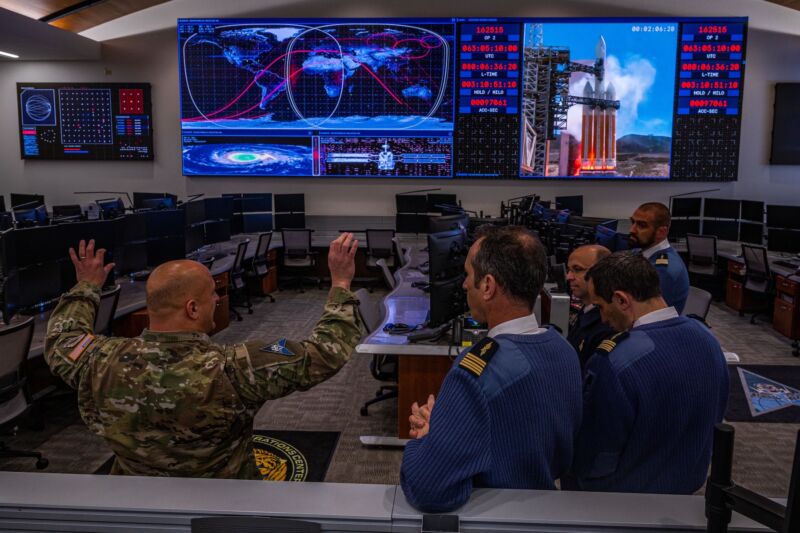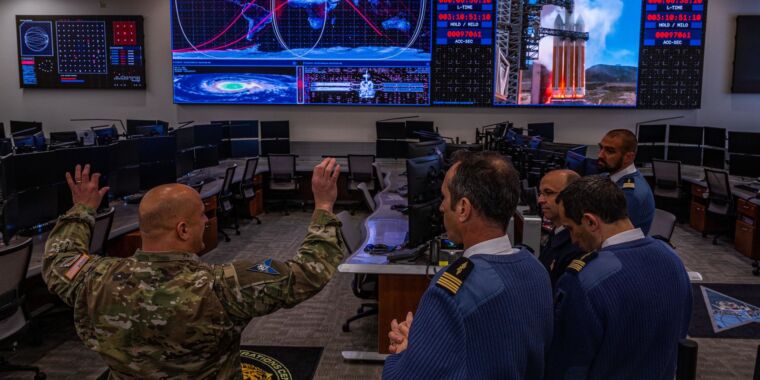Secret military space programs can be a little less secret, Pentagon says

Enlarge / A delegation of French military officers visited the Combined Space Operations Center in 2022 at Vandenberg Space Force Base, California.
Late last year, Deputy Secretary of Defense Kathleen Hicks signed a memo to overhaul a decades-old policy on how the Pentagon keeps sensitive military space programs secret. However, don’t expect defense officials to openly discuss everything they’re doing to counter China and Russia in orbit.
John Plumb, assistant secretary of defense for space policy, revealed the policy change in a roundtable with reporters on January 17. For many years, across multiple administrations, Pentagon officials have lamented their inability to share information with other countries and commercial partners. Inherently, they argued, this stranglehold on information limits the military’s capacity to connect with allies, deter adversaries, and respond to threats in space.
In his statement last week, Plumb said this new policy “removes legacy classification barriers that have inhibited our ability to collaborate across the US government and also with allies on issues related to space.”
But Plumb was careful to point out that the memo from Hicks calls for “declassification, not unclassification” of military space programs. “So think of it as reducing classification.” Effectively, this means the Pentagon can make sensitive information available to people with lower security clearances. More eyes on a problem usually mean better solutions.
New policy for a new century
Some of the Pentagon’s most secret space technologies are part of Special Access Programs (SAPs), where information is highly compartmentalized, and only a few officials know all facets of the program. With SAPs, it’s difficult or impossible to share information with allies and partners, and sometimes officials run into roadblocks even discussing the programs with different parts of the Defense Department.
“Overall, the department does overclassify,” Hicks told reporters in November.
Generally, it’s easier to assign a classification level to a document or program than it is to change the classification level. “The originator of a document, usually a foreign policy or national security staff member, decides if it needs to be classified,” wrote Bruce Riedel, a 30-year veteran of the CIA and a former advisor to four presidents. “In almost all cases this is a simple decision. Has its predecessors been classified? If so, classify.”
The government has periodic reviews to determine whether something still needs to be classified, but most of the time, secret documents take decades to be reviewed. If they are released at all, they generally have value only as part of the historical record.
The declassification memo signed by Hicks is, itself, classified, Plumb said. Hicks signed it at the end of last year.
“What the classification memo does generally is it … really completely rewrites a legacy document that had its roots 20 years ago,” Plumb said. “And it’s just no longer applicable to the current environment that involves national security space.”
The Pentagon has identified China as the paramount national security threat to the United States. Much of what the Pentagon is doing in space is geared toward maintaining the US military’s competitive advantage against China or responding to China in cases where Chinese capabilities may threaten US assets in orbit.
This overarching focus on China touches on all military space programs and the NRO’s fleet of spy satellites. The military is launching new constellations of satellites designed to detect and track hypersonic missiles, demonstrating their ability to quickly get a satellite into orbit, and is interested in using commercial space capabilities from US industry, ranging from in-space refueling to broadband communications.
“Our network of allies and partners is an asymmetric advantage and a force multiplier that neither China nor Russia could ever hope to match,” Plumb said.
Officials have said the threat environment requires the military to be more agile. It’s more vital to collaborate with allies and commercial partners.
Secret military space programs can be a little less secret, Pentagon says Read More »
